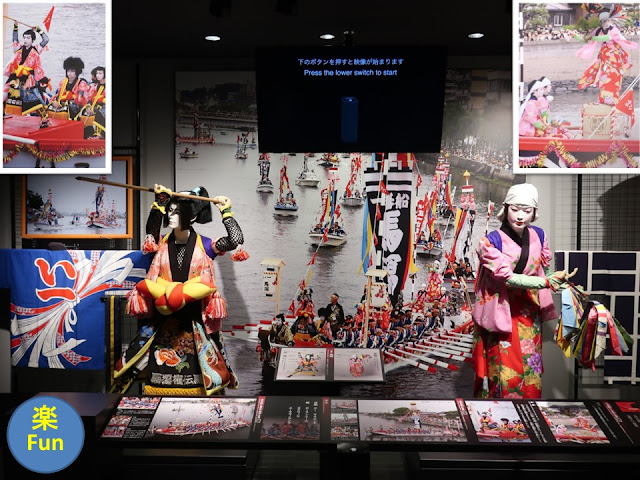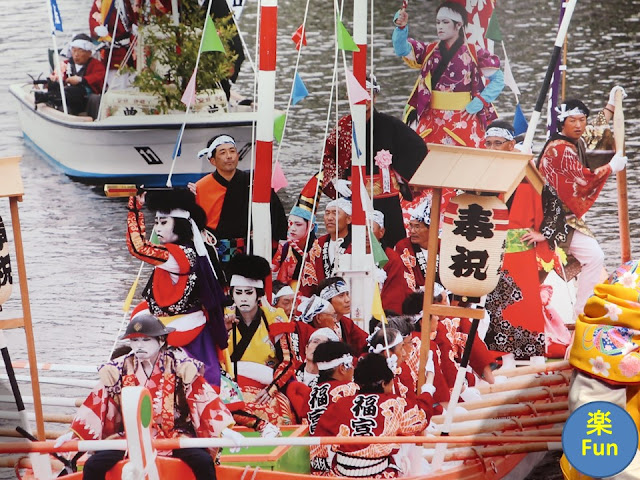“Horan enya” is a Shinto ritual which is held every ten years. Matsue people are passionate about it. Decorated boats parade.
船神事・ホーランエンヤは、松江の人たちが情熱を捧げる10年に一度の祭り(松江城にある城山稲荷神社の式年神幸祭)です。
The museum is next to Matsue History Museum. There are banner-flags in front of the museum; names of five villages, which ships join the ritual, are dyed on them.
伝承館は、松江歴史館のすぐ隣り。飾られた船を出す五大地(集落)ののぼりが上がっています。
Horan enya is the ritual to pray for stability and fertility in the Izumo region. They bring the Divine Spirit of Matsue Jozan Inari Shrine to Adakaya Shrine in Higashi Izumo by boat, which is around 10 kms away. It is 9 days ritual including returning to Matsue. The lord of Matsue-han (local government in the feudal era) initiated it in 1648 when bad weather continued.
ホーランエンヤは、松江城内・城山(じょうざん)稲荷神社の「御神霊」を10km離れた本務社(阿太加夜神社/あだかや)へ運び、五穀豊穣を祈願する9日間の船神事です。櫂をかくときの言葉が「ホーランエンヤ」の由来のようです。1648年の天候不順の折に、松江藩主が始めました。
In 1808, the boat came close to be wrecked by the storm. However, fishermen of Makata village helped the boat and escorted near the shrine. It was the origin of “Horan enya” ritual. Then, four villages joined to guard the boat of the divine spirit. Afterword, they have decorated their boats, have danced on it and have paraded to the shrine.
1808年、暴風雨で神輿船が危険になった時に、馬潟村の漁師が助けて阿太加夜神社近くまで送り届けたのが今の神事の始まりです。その後、四地区が加わり、今は五地区(五大地)が装飾を凝らした船上で、踊りを披露しながら船行列を繰り広げています。
There are five boats in total, and each boat is shown by dolls, photos and video. The first one is belonging to Makata village which has 180 families. A lad stands at the bow, the other one disguised as a woman stands at the stern; they dance. It is honor for them to perform the role. I watched their efforts on TV; they have practiced a lot.
五つの船が人形、写真、映像で紹介されています。一番船の馬潟地区です。船首は少年(剣櫂)が、船尾には女装した少年(采振り)が乗り、舞を披露します。この役に選ばれるのはたいへん名誉なことです。TVで見ましたが練習を重ねてこの役を果たします。この地区は約180世帯です。
The second boat is from Yata, however only 35 families live there. I guess they all out.
二番船は矢田地区。35世帯の地区ですので、総出かもしれません。
The third boat is from Ooi which has 81 families.
三番船は大井地区。81世帯です。
The fourth one is from Fukutomi which has 35 families.
四番船の福富地区は35世帯。
The last one is from Omizaki which has 52 families. Around one hundred boats in total escort the ship of the divine spirit and parade on the sea.
五番船の大海崎地区は52世帯。合計100隻の船行列で神輿をお送りします。
The photo above shows “Horan enya” in 1929. The boat arrived at the shrine at 7:30 PM. It might be after dark. They were so excited.
1929(昭和4)年のホーランエンヤにも鈴なりの見物人が集まりました(5月18日)。神輿が阿太加夜神社に到着したのは午後7時半だったそうです。熱いですね。
“Horan enya” in 1985. It says, “Around 120,000 spectators gathered and were captured by the dance performance. They gazed at the one-kilometer procession.”
The last one was held on 18th to 26th of May in 2019, so the next one will be held in 2029.
1985(昭和60)年のホーランエンヤ。「約12万人の観衆が集まり、櫂伝馬踊りに酔いしれ、1kmにおよぶ船行列を見守った」と書かれています。
前回は、2019年5月18日(土)~26日(日)に開催されました。次回は2029年の予定です。
They prepare for it around one year. Their efforts are rewarded by the excited spectators. Plus, they probably strengthen their bond.
一年前から続く祭りの準備。この努力は、祭りに酔いしれる観衆によって報われます。また、仲間との絆もきっと強くなります。
The actual boat of Makata is set at the garden of the museum.
屋外には櫂伝馬船が展示されています。
Jozan Inari Shrine where the spirit resides is unexpectedly a quiet place.
御神霊が鎮座する城山稲荷神社は、意外とひっそりとしていました。
Visited in November, 2022
Official website: https://matsu-reki.jp/ho-ranenya/horanenya
(in Japanese), accessed in May, 2023
English
brochure: https://matsu-reki.jp/ho-ranenya/wp-content/uploads/2022/06/panf_eng.pdf
Previous post (neighboring museum): Matsue
History Museum、松江歴史館
Next post (museum in the neighboring prefecture): Daisen Museum of Nature and History、大山自然歴史館














Comments
Post a Comment